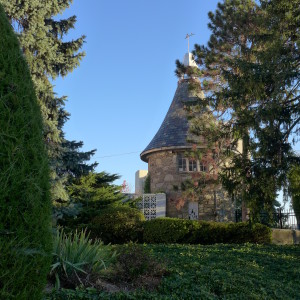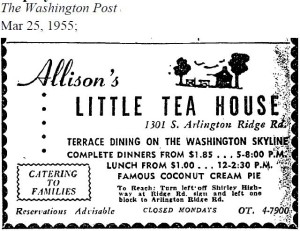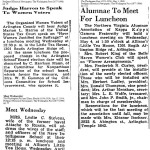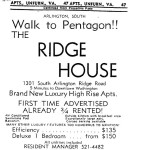Preserved & Developed: Allison’s Little Tea House
Preserved & Developed is a weekly series of articles by Preservation Arlington highlighting local development projects that have involved both development of a site and preservation of historic resources. The projects highlight a wide range of challenges and solutions over many years. At the time they were completed the projects represented a commitment by the developer and the community to embrace the future and preserve the past. Preservation Arlington is awarding each project a gold, silver, or bronze star based on the extent to which the project protected historic resources within its particular constraints.
In the 1950s, Allison’s Tea House — a coveted neighborhood restaurant at 1301 South Arlington Ridge Road that had been visited by dignitaries including Amelia Earhart and Eleanor Roosevelt — was slated for rezoning, which was opposed by the local civic association. While the County Board ultimately denied the rezoning, the site did get developed by-right as an apartment building in the early 1960s. In the end, the developer did retain one building from the original site. The stone well house on the property was modified and is now used as a storage house for the apartment building’s swimming pool.
Gertrude Allison Brewster, owner of both the Tea House and the property, went before the County Board at their April 19, 1952, hearing, with a rezoning request for her property from RA6-15 to C-1 (multi-family residential zone to a low-density commercial zone). The Zoning and Land Use Committee recommended that this zoning application be denied. The Arlington Ridge Civic Association also testified at the meeting and voiced their opposition to the rezoning.
Ms. Brewster offered that she “would be willing to execute an agreement whereby if the property were rezoned to C-1, Local Commercial, and subsequently an attempt was made by her or her successors in title to use the property for purposes other than the operation of a tea house, the Board could immediately rezone it back to RA6-15 on its own motion, and she would waive any defenses to the action.”
The board moved to defer any decisions to December 12, 1953, and require that the applicant prepare an agreement as described by her attorney, that the Commonwealth’s Attorney render his legal opinion on the same, and that the agreement be presented to the Arlington Ridge Civic Association and other interested property owners, prior to being submitted to the Board at the time of the hearing. That motion carried 3-2. At the December meeting, the rezoning request was denied by a vote of 4-1.

Opened in 1920, the Little Tea House restaurant hosted many famous people including Roosevelt and Earhart, and Oliver Wendell Holmes. Known for its lovely gardens and views, it was also one of the first places in Arlington where racially mixed groups could meet.
Gertrude Crocker, who started the restaurant, was active in women’s issues throughout her life and started the restaurant so she could be independent and her own boss. When Mrs. Crocker leased, and later sold, the business to Gertrude Allison Brewster, it became known for a period as Allison’s Little Tea House, according to Arlington’s Center for Local History. A postcard produced for the Little Tea House described the restaurant this way:
Reminiscent of early American days with its brass and copper antiques, its shelves of rare old cook books, its tinkling Swiss music box, Allison’s Little Tea House has been devoted for the past quarter of a century to the art of gracious eating.

In the late 1950s and early 1960s housing was being built as quickly as possible. The Arlington Ridge area, with its access to Shirley Highway and the Pentagon, was a prime location and had the right zoning for mid-rise apartment buildings. The three-building River House complex was completed in 1957, 1960, and 1962, the Cavendish in 1958, Parliament House in 1964, and Horizon House in 1965. In 1963 Allison’s Tea House was demolished and the Ridge House was built and opened by 1965. The eight-story, 89-unit Ridge House operated as apartments until it was converted to condominiums in 1979.
The lone sentinel well house building left over from Allison’s Little Tea House is now surrounded by mid-rise apartment buildings and serves as a reminder of a time, just like today, when people came to that location for the view of downtown D.C. and easy access to jobs. A little of the old mixed in with the new reminds us and connects us to our past.





One thought on “Preserved & Developed: Allison’s Little Tea House”
I absolutely love these articles and pictures of the “Old Arlington” treasures.